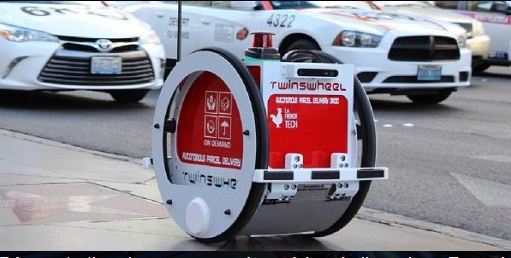The drone would live at this time the same revolution as smartphones with the photo, according to Parrot. Because we can take very good shots with a very small sensor, the brand does not see the interest to make big and firmly believes that the future is ultra-compact drones.
It has just presented the new ANAFI Thermal model that will be marketed in May 2019 at a price of 1900 euros excluding tax. An all-in-one solution including the drone, sensor and FreeFlight 6 software.
The ANAFi Thermal is in line with the previous ANAFI high-end consumer model released in 2018, but it has further refined. This electric quadricopeter is lighter (315 grams against 320 for its elder) and is slightly smaller (21.8 cm against 24 cm). "An ultra-compact UAV is safer, more affordable financially, it can fly in indoor, and it is suitable for all needs," aligns the founder and president of Parrot Henri Seydoux.It still has a 4K HDR camera. But the main novelty is of course the infrared camera. The resolution is 160 x 120 pixels, with a temperature range of -10 degrees to 400 degrees, and a thermal sensitivity of less than 50 mK.
The quality is sufficient to zoom in the thermal image. This allows, of course, to see in the dark but also superimpose in daytime and in real time the thermal images on those of the photo sensor. You can activate different features on the image return displayed on a tablet: search for an object with a precise temperature, automatically select hot spots and cold spots or start manual searches.
If Parrot repeats on all the tones that his drone is also addressed to individuals, it is hard to see what the general public would do, not to mention the high price of access. Asked if Parrot hopes to compete with Chinese drones and make turnover with ANAFI Thermal, Henri Seydoux's answer is cautious. "The consumer drone bubble is deflating and the market will continue to fall further. That's why we need to redirect our products to more profitable margins. " It is therefore in fact to the professionals that this last model addresses.For companies, the price seems rather affordable compared to the rest of the market. It usually takes at least 3,000 euros for a drone and a thermal sensor. The uses are varied: protection of wild animals, counting herds, inspection of buildings or solar panels, surveillance of risk areas like volcanoes or forest fires, etc .. The whole is compatible with the solution FLIR Tools for edit inspection reports.
The choice of Parrot is rather clever: adapt his high-end consumer drone for professionals by adding a thermal camera. This allows him to release this model at a very attractive price. It will be necessary to see if the orders are with the rendezvous.
The Franprix brand is testing an autonomous robot-caddy
The Franprix brand is currently testing in one of its Paris stores a small autonomous droid capable of transporting 40 kg of products to clients' homes. Two large wheels surrounding a square box surmounted by a red beacon. This is what looks like this strange delivery robot who goes back and forth on the sidewalk, in front of a Franprix store in the 13th arrondissement of Paris, to the delight of children. Welcome to a window of the future, where the elderly or handicapped can be helped by a droid during their shopping.
This little machine, like three apples, developed for five years by the start-up Lyon TwinswHeel, has not yet a name. But his co-founder, Vincent Talon, calls him "fast courier" or, more futurist, TH03. At present, there are only twenty in the world, including some at Renault, the SNCF to carry heavy loads, or in Germany at Siemens, to bring meal trays in offices.Demonstration in a Paris store of the Franprix brand with Geneviève, a customer who has always been willing to serve as a guinea pig. Genevieve is facing the droid to scan it: it is she he will follow. Then she presses the "follow me" button and starts wandering the aisles. And hop, milk, she opens the box, drops the bottle and leaves. And hop, butter, same gestures. As soon as it stops, TH03 stops. She leaves, he follows her, taking turns without bumping. It runs on electricity and can carry up to 40 kg.
During the six months that this test will last, two robots will be made available to customers to assist them for free in their races, then drive home, at a speed of 6 km / h. "They can help people with reduced mobility regain freedom of movement, go out more often and socialize again," says Jean-Paul Mochet, General Manager of Franprix.But why spend so much time testing? "We have to confront these robots, designed in the workshop, to reality. Thanks to artificial intelligence, they will learn from their mistakes, "explains Vincent Talon. An example ? If there are too many people, the robot does not know which user to turn to and can change "partner" along the way! The biggest risk today? That we do not see it. "But as it is loaded with sensors (2D, 3D, ultrasound, infrared cameras), it stops as soon as it detects an obstacle," reassures the co-founder.
What will be the next steps? Engineers, elected officials or distributors ... all here are campaigning for a legislative change, because for the moment, the little droid, like autonomous cars, has no right to travel alone in the city. He must therefore be accompanied by an employee of Franprix, for the return journey. "It is necessary that the law authorizes experiments," claims the mayor of the 13th, Jerome Coumet, who closely follows the experience. "In the long run, the field of possibilities is impressive," says Jean-Paul Mochet, of Franprix. Thus, one day, the robot can for example return from home to the store, not empty but with packaging to recycle.







No comments:
Post a Comment